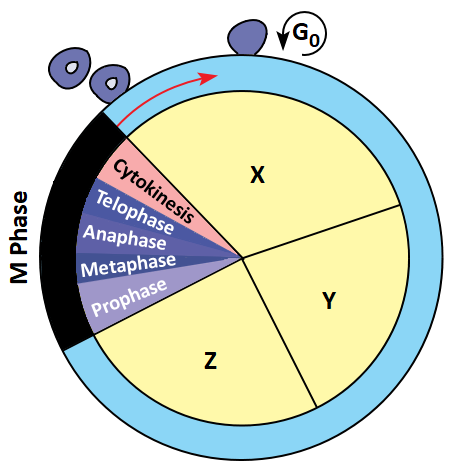Liquid endosperm in coconut is resulted due to:
1.
Karyokinesis followed by cytokinesis
2.
Failure of karyokinesis followed by cytokinesis
3.
Karyokinesis twice followed by single cytokinesis
4.
Karyokinesis is not followed by cytokinesis
The above graph shows the change in DNA content during various phases (A to (d) in a typical mitotic cell cycle. Identify the phases:
|
|
A |
B |
C |
D |
|
(1) |
G2 |
G1 |
S |
M |
|
(2) |
G |
S |
G2 |
M |
|
(3) |
G1 |
S |
G2 |
M |
|
(4) |
M |
G1 |
S |
G2 |
A reduction step during meiosis is important because:
| 1. | It returns the chromosome number to normal before fertilization |
| 2. | There is a mechanism for this |
| 3. | Only one copy of each chromosome is necessary |
| 4. | Otherwise chromosome copies would double each fertilization |
The DNA content of individual cells and the number of cells in each phase of a "cell cycle" can be determined, using flow cytometry. Which of the following combinations of "phase of a cell cycle and its corresponding DNA content" can be considered normal?
| A. | Diploid cells found in the Go or G1 phase. |
| B. | Cells with twice the normal DNA content in the early M phase. |
| C. | Cells with intermediate amounts of DNA in the S Phase. |
| D. | Cells with twice the normal DNA content in the G2 phase. |
1. A and B
2. B and C
3. C and D
4. All are correct
The following diagram refers to a typical cell cycle.
Identify the parts marked as X, Y and Z.

| 1. | X - G1; Y - S; Z - G2 |
| 2. | X - G2; Y - S; Z - G1 |
| 3. | X - G0; Y - S; Z - G2 |
| 4. | X - G1; Y - G2; Z - G0 |
Identify the meiotic stage in which the homologous chromosomes separate while the sister chromatids remain associated at their centromeres:
| 1. | Metaphase I |
| 2. | Metaphase II |
| 3. | Anaphase I |
| 4. | Anaphase II |
Select the correct statement about G1 phase:
(1) Cell is metabolically inactive
(2) DNA in the cell does not replicate
(3) It is not a phase of synthesis of macromolecules
(4) Cell stops growing
Which of the following is a continuous process?
| 1. | Cell growth |
| 2. | Cell differentiation |
| 3. | DNA duplication |
| 4. | Cell division |
Cell growth is a continuous process in terms of
| 1. | Increase in protein content |
| 2. | Increase in DNA content |
| 3. | Increase in cytoplasmic content |
| 4. | Increase in RNA content |
The process of distribution of duplicated DNA in the daughter cells is
| 1. | Easy process |
| 2. | A complex series of events |
| 3. | A single complex process |
| 4. | Easiest process in all the events of cell cycle. |







